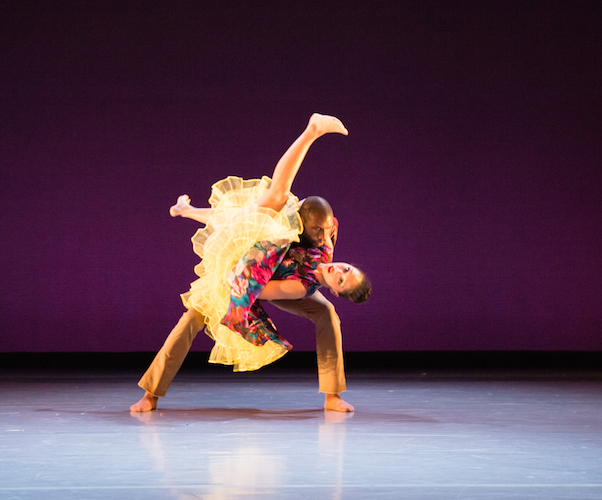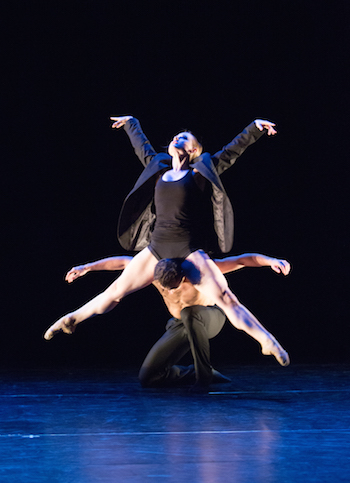Dance Review: BalletX — Fusion and Diffusion
Ballet steps from the classroom were sprinkled in with modern dance, moonwalking, shimmies, groping duets, and any other kind of movement that stretched and angled the ten dancers’ bodies in sensuous ways.

A scene from BalletX’s “Slump.” Photo: Alexander Iziliaev.
BalletX presented by World Music CRASHarts at Institute of Contemporary Art, Boston, MA, October 21 and 22.
By Marcia B. Siegel
All four pieces by the Philadelphia-based contemporary company BalletX came out of the same sensibility although the program was probably meant to show off a stylistic range. The idea, suggested by the company title, was to defeat the notion of classical ballet as the defining aesthetic of dance in the 21st century. The barriers between ballet and modern dance began to crumble half a century ago. By now, ballet is only one among many items in a dancer’s training, alongside modern dance, jazz, and street dance forms like hip hop and break dancing — ultimately a dancer should be able to do everything. The classical idiom survives and grows in a small number of accomplished post-Balanchine choreographers like Alexei Ratmansky. But most theater dance we see now is a mashup of many styles. “Ballet” is only one of them.
In BalletX’s eclectic program we saw a couple of actual ballet passages, notably Andrea Yorita’s pointe variations in Joshua L. Peugh’s Slump and Matthew Neenan’s The Last Glass. The rest of the evening, ballet steps from the classroom were sprinkled in with modern dance, moonwalking, shimmies, groping duets, and any other kind of movement that stretched and angled the ten dancers’ bodies in sensuous ways.
All the items on the program featured recorded musical fusions or collages. Even Amy Seiwert’s duet It’s Not a Cry, which had only one song, was a mix, a cover of Leonard Cohen’s “Hallelujah” sung by Jeff Buckley. Reflecting none of the song’s eroto-religio mystification, It’s Not a Cry looked like almost any other modern ballet duet, with more elaborate supporting and separating moves than usual. Chloe Felesina and Richard Villaverde grappled effectively.
Slump, the program opener, had a string of musical selections that smashed Yma Sumac and Ella Fitzgerald in between numbers by a Klezmer band. The ten dancers offered nonstop jivey games, improvisational looking mambos, a tiny moonwalking solo.
Whatever kooky individuality might have been suggested at the beginning had evaporated by the end of the piece because any one person’s engaging moves quickly multiplied into unison or rudimentary two-part patterns. A duet (Felesina and Zachary Kapeluck) to Ella’s fine, slow “Yesterdays” brought the tempo down to earth for a moment.
Jorma Elo’s Gran Partita, made by the company in 2014, pitted classical music (Mozart, Bach) against atonal clangor from Alban Berg’s “Lyric Suite,” and a shatteringly beautiful duet of female singers from Monteverdi’s “Coronation of Poppea.” Elo choreographs every part of the body, as continuously as possible, regardless of what music is playing. Gran Partita features the ten dancers in couples. There are almost inadvertent group patterns, piercing light effects (designed by Drew Billiau), overall reflections of musical moods.

A scene from BalletX’s “It’s Not a Cry.” Photo: Alexander Iziliaev
Matthew Neenan’s The Last Glass (2010) wound up the evening with a musical medley from the indie-rock group Beirut. Neenan distributes the dancers a little more formally than the other 3 choreographers, with a few of the women on pointe. The movement is very physical, lots of turning and strenuous partner work. Many duets seem only an extension of the individual acrobatics. Men haul the women over their backs and shoulders, drag them on the floor, grab them from behind, fling them out into spacious arcs. The women keep going back for more.
One woman (Felesina) might have misgivings about this treatment. She encounters several men but can’t establish a connection with any one of them. The last of her partners (Gary Jeter II) slides away after failing to conquer her ambivalence. The other couples pass through upstage. Felesina faces the audience and mimes a certain rueful loneliness.
I used to view music and dancing together, but recently I’ve become much more conscious of the music because it so often doesn’t relate to the dancing. In Neenan’s piece, the Klezmerish music, with its blaring bullring trumpets and a strained tenor voice singing half-intelligible words, grated on my ears and defeated whatever sense it might have given to what I was seeing.
This program left me feeling empty. Contemporary dance prides itself on its diversity, its ability to capture the audience, which liked the skilled and attractive dancers. It liked the high intensity, the acrobatics, the sexy bodies, the superlative physicality, the simulated romance.
The message that nothing very demanding of an elitist nature can occur gives the contemporary viewer confidence. But the discredited, elitist idea of a vocabulary (whether ballet, modern dance, or anything else) gives a choreographer and an audience a set of ground rules with which to construct meaning. That, really, is the essence of choreography. As in the election campaign, people aren’t responding to meaning, but to theatrics, agility, and self-regard. I’d like to think we can ask more of dance art.
Internationally known writer, lecturer, and teacher Marcia B. Siegel covered dance for 16 years at The Boston Phoenix. She is a contributing editor for The Hudson Review. The fourth collection of Siegel’s reviews and essays, Mirrors and Scrims—The Life and Afterlife of Ballet, won the 2010 Selma Jeanne Cohen prize from the American Society for Aesthetics. Her other books include studies of Twyla Tharp, Doris Humphrey, and American choreography. From 1983 to 1996, Siegel was a member of the resident faculty of the Department of Performance Studies, Tisch School of the Arts, New York University.
